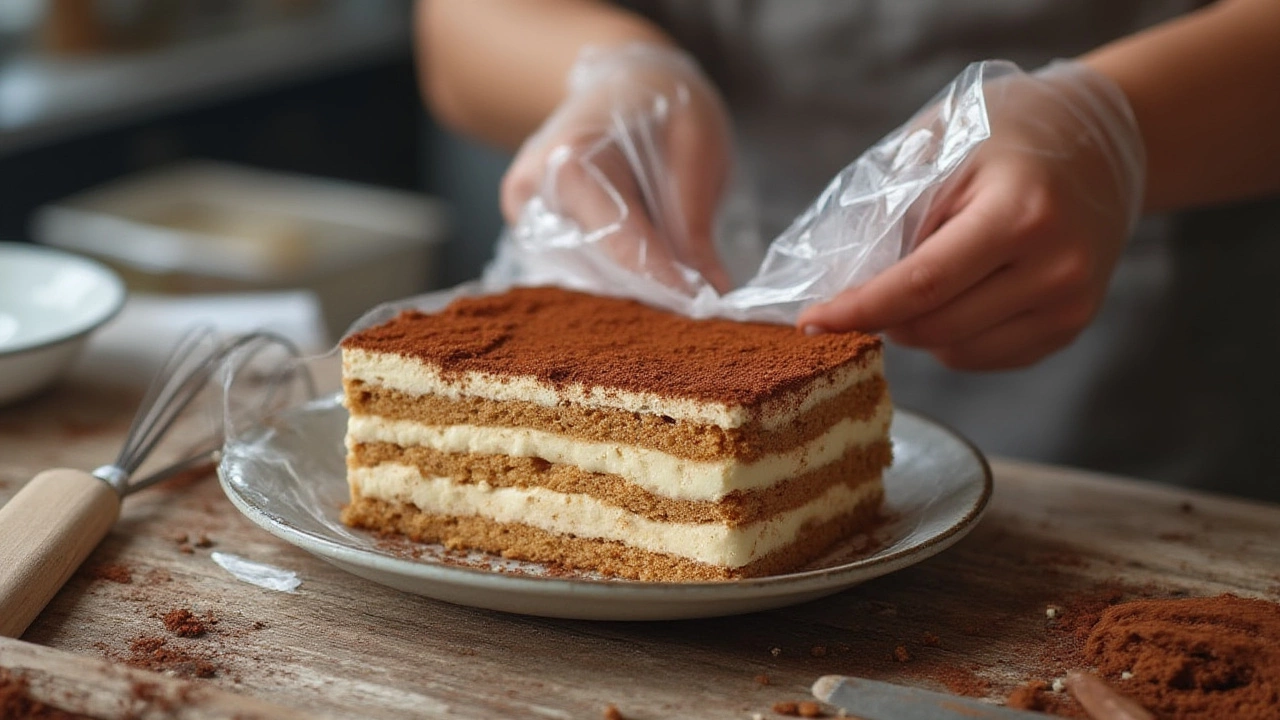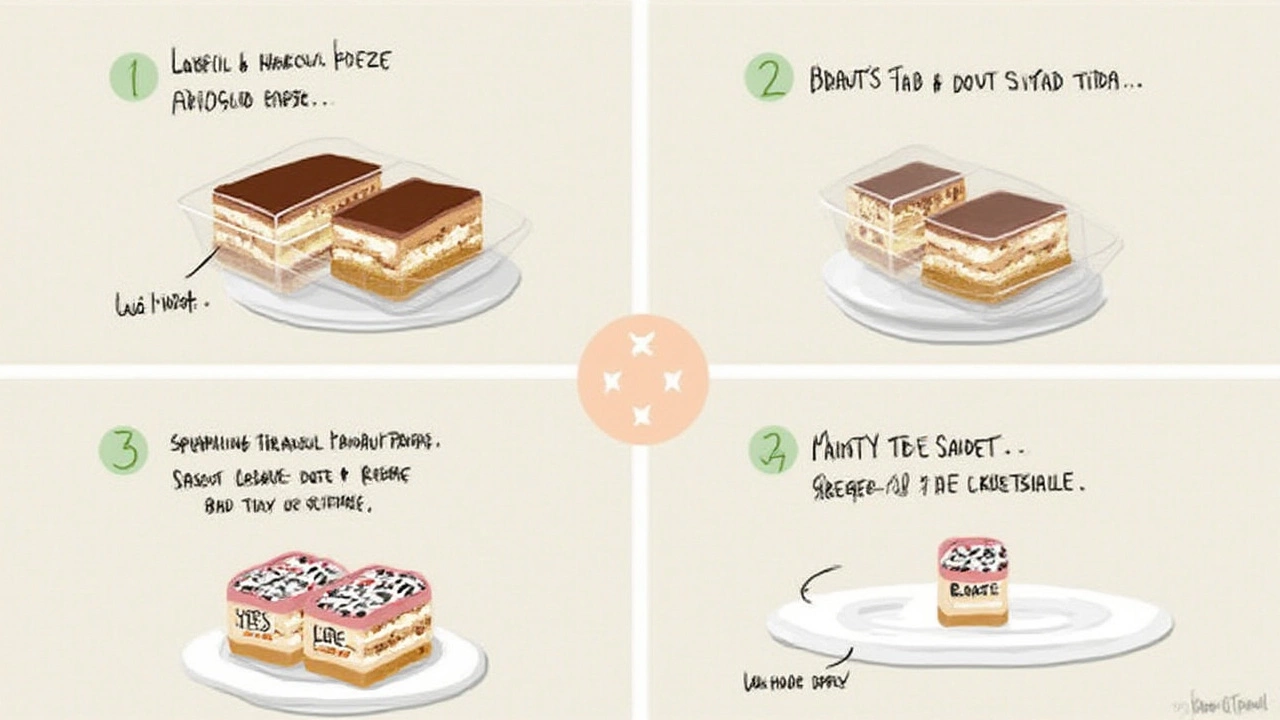
There’s something quietly daring about pulling a homemade tiramisù from your freezer late at night, spoon in hand, hoping that time and cold haven’t stolen that rich, silky drama. But that’s the thing: tiramisù straddles two food worlds—blissful, airy dessert and fragile chemistry project. People whisper about freezing it: is it a flavor crime, or actually genius? Once, at a family get-together, I caught my own kids—Thalia and Dariel—digging into a frosty square I’d hidden last month, and it was still all creamy comfort and punchy espresso. That’s when I figured: it’s time to stop guessing and lay out the real guide to freezing tiramisù for good.
The Science of Freezing Tiramisu: What Happens to Texture and Taste?
Tiramisu isn’t just cake. It’s got mascarpone, eggs, espresso-soaked ladyfingers, cocoa—in other words, a mish-mash of high-fat dairy, delicate proteins, and lots of moisture. Freezing works differently on each of these. Mascarpone is notorious for separating when frozen, thanks to its high water and fat content. That can lead to a slightly grainy texture if you’re not careful. The eggs, if raw, can alter in structure, but most mainstream tiramisù recipes use pasteurized eggs or even skip them, so food safety is less of a concern if you adapt your ingredients. The ladyfingers, after their espresso bath, can turn mushy in the freezer if the dessert is already soggy before it’s frozen. Cocoa dusting tends to hold up fine, though the flavor might mellow just a little.
Still, when done right, the results will impress even a picky Italian grandmother. Freezing actually can intensify flavors; the dessert’s elements have time to meld and mellow. No scientific paper compares frozen-and-thawed tiramisù to fresh, but experienced bakers in Italy quietly admit that frozen slices, if wrapped caringly, hold up shockingly well for up to two months. Let’s look at this table for a quick reality check:
| Component | Reaction to Freezing | Tips to Prevent Damage |
|---|---|---|
| Mascarpone Cream | May separate, turn grainy | Whisk after thawing |
| Ladyfingers | Can get soggy or dry out | Don’t over-soak before freezing |
| Cocoa Powder | Flavor might dull | Re-dust after thawing |
| Eggs | Possible texture change | Use pasteurized, avoid freezing raw-egg heavy versions |
So, the science doesn’t say 'never freeze tiramisù.' It just asks you to plan ahead. A firmer set, slightly less soak in the ladyfingers, and a sturdy, full-fat mascarpone go a long way. Homemade or store-bought, most tiramisù can take a brief frosty nap and come back swinging—if you treat it right.
How to Freeze Tiramisu Like a Pro: Steps for Perfect Results
Now, before you stick that precious tray in the freezer, pause. If you want your tiramisù to taste as dreamy once thawed as it did on day one, you need a game plan. Here’s how I tackle it, step by step, based on trial, error, and endless dessert emergencies late at night (thank you, parenthood):
- Chill before freezing: Let the tiramisù set in the fridge for at least 4 hours, or overnight, before even considering the freezer. This helps all those creamy layers settle and become firmer, so they freeze evenly.
- Divide into portions: Life hack: slice the tiramisù into what you consider a ‘reasonable’ serving (I go generous because who are we kidding?) and freeze those slices individually. That way, you can defrost only what you need—much easier than hacking away at a frozen brick later on.
- Wrap tightly: Each portion should go into plastic wrap first, then into aluminum foil, or inside a freezer-safe airtight container. Air is your enemy here—it will introduce freezer burn and unwanted odors.
- Label and date: Yes, you’ll forget when you made it. A little tape, date, and description (“Tiramisu: with Kahlua, no raw eggs!”) will make you look like an organized genius to future-you.
When it comes to how long you can leave it in there, two months is the sweet spot. Any longer, and even the best-wrapped tiramisù will start to pick up freezer funk. Here are a few extra tips:
- If your recipe uses heavy cream instead of raw eggs, freezing will work even better—that’s part of why some restaurant tiramisù holds up so well in commercial freezers.
- Before serving after freezing, re-dust with cocoa or a whisper of espresso for fresh flavor.
- When freezing a whole tiramisù, line the bottom of your dish with parchment paper first; it’ll make lifting out blocks for future snacks much easier.
A lot of people overlook how well this dessert behaves as a frozen treat. In fact, you can even enjoy it semi-frozen, like an ice cream cake. The texture changes, sure, but in summer, my kids have begged for it this way because it’s refreshing without being icy.

The Best Way to Thaw Tiramisu: No Soggy Surprises
This is where people get antsy: thawing tiramisù. Go too fast, and you risk mushy ladyfingers or a watery mascarpone layer. Here’s what works best for most home cooks:
- Thaw in the fridge. Move the frozen pieces (or whole tray) from the freezer to the fridge the night before you plan to eat it. Slow thawing keeps everything creamy and close to the original texture.
- Skip microwave or countertop thawing. Don’t get impatient. Rapid temperature swings make the layers separate and go weepy. This isn’t a dinner roll—give it time.
- After thawing, inspect the layers. If the mascarpone looks separated, just whisk it gently with a fork. Sometimes a little love brings it all back together. For ladyfingers edging toward soggy, a quick blast (just seconds!) in the coldest part of your fridge can help firm things up.
One fun trick: slightly frozen tiramisù is easier to slice—think about it if you’re aiming for neat squares for a party. If you ‘over-thawed’ and the top looks soft, a bit more dusting of cocoa covers blemishes and freshens up the aroma. If you’re feeling extra, adding a couple of chocolate shavings or some roasted nuts on top brings back some texture pop.
There’s some disagreement about whether tiramisù improves, stays the same, or risks losing a step after freezing. A blind taste test among my friends and shushed kids found almost no difference between properly frozen and fresh, though texture can shift a little. If you care about looks over taste, just set your expectations that the top might not win a beauty contest, but the flavors will be there.
Creative Uses for Frozen Tiramisu: Beyond the Usual Slice
Okay, so maybe you made too much tiramisù, or you got ambitious and now there’s half a tray lurking in your freezer and you’ve tired of serving it up straight. This is where things get fun. Don’t just think of tiramisù as a simple chilled dessert—freezing opens up a few creative side doors. Here are some ideas from my kitchen to yours:
- Tiramisu Milkshake: Blend a chunk of frozen tiramisù with a little vanilla ice cream and a splash of cold coffee. Heaven in a glass.
- Tiramisu Truffles: Take thawed tiramisù, roll it into balls, freeze those, and dip in melted dark chocolate. Easy, bite-sized party treats.
- Espresso Parfait: Layer crumbled frozen tiramisù with extra whipped cream and chocolate chips in a glass for a decadent twist on the original.
- Ice Cream Sandwiches: Use slabs of frozen tiramisù between crisp cookies for a playful dessert hybrid.
- Tiramisu Affogato: Drop a cube of frozen tiramisù in a hot shot of espresso. Instant drama, zero effort.
You can also portion and freeze tiramisù into silicone muffin cups or small ramekins—perfect for single servings you can pop out on demand. I promise, if you ever need to bribe a kid to clean their room, the sight of a personal tiramisù cup with chocolate flakes on top works like magic (tested many times on Thalia and Dariel).
And if you’re the type to tweak recipes, this knowledge opens up new doors: try making a batch specifically for freezing next time, with a slightly stiffer mascarpone layer and just a bit less espresso for soaking. Then surprise everyone at the family BBQ with a perfectly chilled Italian treat, and let them guess how you managed such a feat in July.
So yes, you absolutely freeze tiramisu and expect delicious results—if you prep, store, and thaw it with a little care. Every save in the freezer is a future treat for a busy night or surprise guest. And honestly? That’s exactly the kind of dessert magic we need more of in real life.




